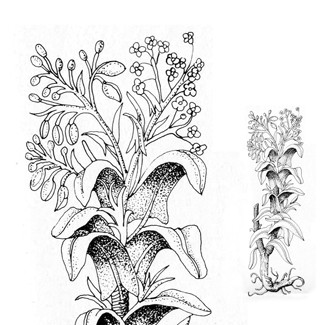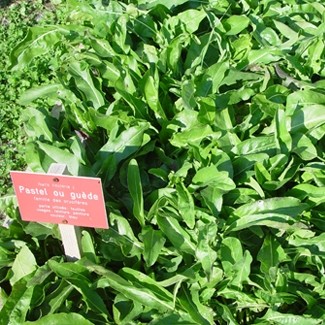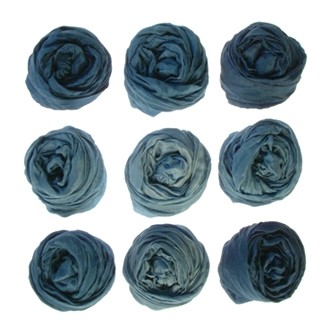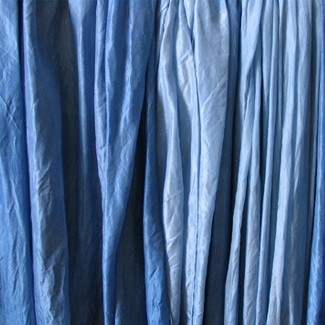| Woad
Isatis tinctoria I.
The Plant
Plant belonging to the Cruciferae , herbaceous, perennial and common in Europe.
It has glaucous colored lance shaped leaves and blooms from May to June with yellow clustered flowers speckled with violet and brown.
The plant reaches a height of one meter.
Findings of blue colored linen and canvas cloth dating back to the Neolithic, document the ancient use of woad from the Black Sea to Europe and from India to North Africa.
Plinius wrote that the ancient Britons, with the intention of inflicting terror on their enemy, used this plant to paint their bodies.
It was already known, and appreciated as well, as a medicinal plant (astringent) in ancient Rome.
Isatis tinctoria reached its maximum distribution in Medieval times. It was cultivated over time in many Italian regions, especially in Nocera in the area surrounding Gualdo, where it got its name Guado (translated Woad).
Woad began to lose importance after large quantities of Indigo, from the Indies and America, were imported to Europe.
Usage
The color is taken from both fresh and dried leaves of the Isatis.
Through processes of soaking and fermentation in water, a greenish yellow color is obtained; the solution, shaken and oxidized, precipitates the blue colored flakes of indigo (indigotina).
Color characteristics
Excellent resistance to light. While washing in water it could lose color.
Eventual traces of color from rubbing against skin or other clothing, above all in the darker colors, is not harmful and can be removed by washing in water.
To preserve the color of scarves dyed in light woad, dry cleaning is preferable.
Bibliography
Franco Brunello “ L’arte della tintura nella storia dell’umanita” Neri Pozza editore – Vicenza;
Gunter Meier ” Colori vegetali. Ricerca, produzione, utilizzo” Associazione Casasana
Ass.ne di Tintura Naturale “Maria Elda Salice” quaderno Le Piante Tintorie
The Plant
Plant belonging to the Cruciferae , herbaceous, perennial and common in Europe.
It has glaucous colored lance shaped leaves and blooms from May to June with yellow clustered flowers speckled with violet and brown.
The plant reaches a height of one meter.
Findings of blue colored linen and canvas cloth dating back to the Neolithic, document the ancient use of woad from the Black Sea to Europe and from India to North Africa.
Plinius wrote that the ancient Britons, with the intention of inflicting terror on their enemy, used this plant to paint their bodies.
It was already known, and appreciated as well, as a medicinal plant (astringent) in ancient Rome.
Isatis tinctoria reached its maximum distribution in Medieval times. It was cultivated over time in many Italian regions, especially in Nocera in the area surrounding Gualdo, where it got its name Guado (translated Woad).
Woad began to lose importance after large quantities of Indigo, from the Indies and America, were imported to Europe.
Usage
The color is taken from both fresh and dried leaves of the Isatis.
Through processes of soaking and fermentation in water, a greenish yellow color is obtained; the solution, shaken and oxidized, precipitates the blue colored flakes of indigo (indigotina).
Color characteristics
Excellent resistance to light. While washing in water it could lose color.
Eventual traces of color from rubbing against skin or other clothing, above all in the darker colors, is not harmful and can be removed by washing in water.
To preserve the color of scarves dyed in light woad, dry cleaning is preferable.
Bibliography
Franco Brunello “ L’arte della tintura nella storia dell’umanita” Neri Pozza editore – Vicenza;
Gunter Meier ” Colori vegetali. Ricerca, produzione, utilizzo” Associazione Casasana
Ass.ne di Tintura Naturale “Maria Elda Salice” quaderno Le Piante Tintorie




